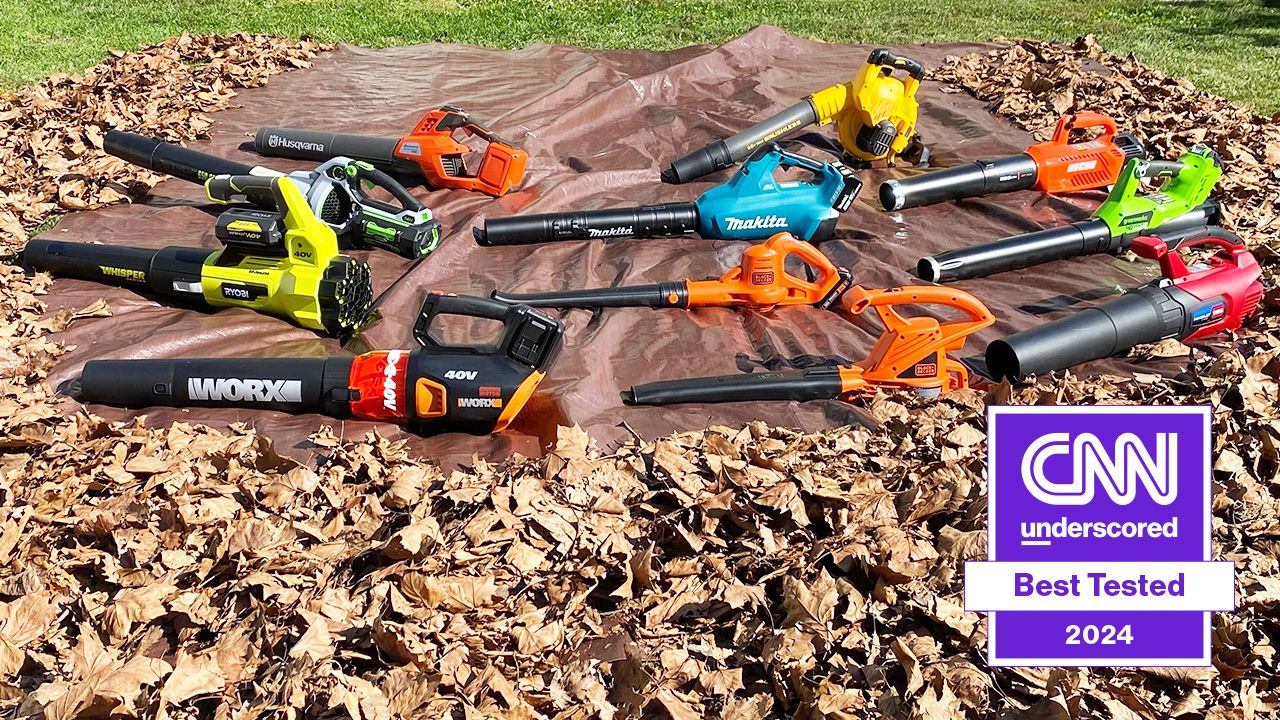The best leaf blowers we tested:
Best leaf blower overall: Ego Power+ LB6504
Best corded electric leaf blower: Black+Decker LB700
If you’re a homeowner who has this season’s fallen leaves piled up all over your lawn and you want them gone, then you have three options: blow and bag them yourself using a leaf blower, hire someone else to blow them or manually rake and bag them. If you choose the first option, then you would join the more than 150 million Americans who owned a leaf blower in 2020, according to Statista. In fact, the research firm projects that, by 2024, more than 237 million homeowners will own some kind of lawn and garden equipment, including electric lawn mowers and leaf blowers.
We’ve set out to help you find the best leaf blower, of which there are many lightweight and relatively inexpensive options. Ignoring gas-powered and backpack models (more on why later), we researched hundreds of electric models and brought in 12 highly rated options for testing. We tested two corded models and 10 cordless models (i.e., powered by rechargeable lithium-ion batteries) from brands including Black+Decker, DeWalt, Echo, Ego, Greenworks, Ryobi, Toro and Worx.
We tested all the leaf blowers by judging each on its ease of use, ergonomic handle and maneuverability, unit weight, power and speed levels, run time and battery life, and sturdiness of construction. After blowing millions of leaves during testing, we found that the cordless Ego Power+ LB6504 is the best leaf blower overall, while the Black+Decker LB700 is the best corded electric leaf blower.
Our winning picks
The Ego Power+ LB6504 is a sturdy, powerful blower that’s easy to use. We could hold it for long periods of time without strain, thanks to its ergonomic handle and comfortable weight, which made it highly maneuverable in our hands. Plus, its rechargeable lithium-ion battery lasted the longest, even at the highest speed level.
The Black+Decker LB700 corded blower is lightweight and surprisingly powerful, and it would fit any budget. If you have a yard on the smaller side or just need a blower to blow leaves and other debris from sidewalks and paths, then this is a good choice for you if you don’t mind using a blower with a cord.
Best leaf blower overall: Ego Power+ LB6504
$279 at Amazon and Ace Hardware
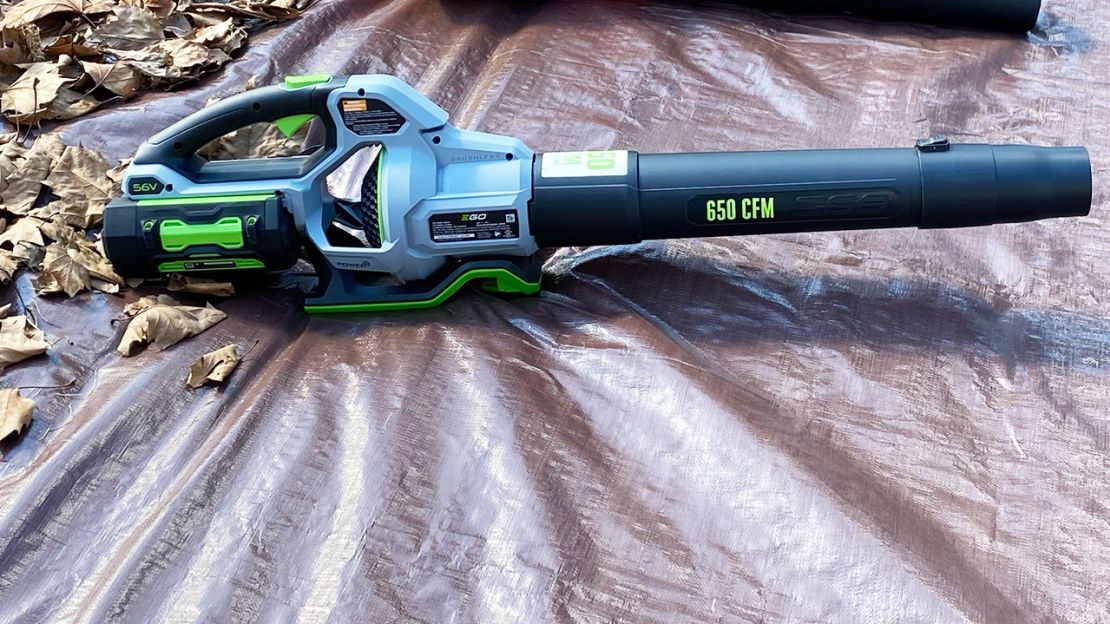
What we liked about it
The Ego Power+ LB6504 blower is easy to use; it was highly maneuverable in our hands. This leaf blower weighs 12.9 pounds, which was a comfortable weight for us to work with. We could hold it for long periods of time without strain, thanks to its sleek, ergonomic handle.
This blower is powerful; we were able to move what seemed like thousands of leaves from their resting place into a huge pile in just a few minutes. The blower features a round speed control dial that let us adjust the force of the airflow in four increments ranging from Off to High. Once we were blowing at the highest speed, we then held down the boost button to activate Turbo Mode for even more strength. We did notice that the blower was noisier on Turbo Mode, but the extra power made it faster to get the job done.
This model is solidly built and easy to control. It comes with two removable nozzles: one flat and one tapered. We found it easy to slide each of them onto the open end of the blower, and they stayed put during use. Both nozzles lengthen the leaf blower, but more importantly, they helped us direct the airflow. The flat nozzle has a narrower opening, which let us concentrate airflow on a particular section of leaves. We preferred the tapered nozzle, which also let us focus the airflow where we wanted, but it just seemed more efficient to use.
Its 5.0Ah lithium-ion battery lasted 25 minutes on a single charge — the longest of all the leaf blower batteries we tested. This was the case even while we used the unit at its highest Turbo Mode speed. Like all the batteries in this test, the battery is rechargeable and comes with its own charger. After use, it took us one hour to get the battery fully charged again.
This leaf blower comes with a five-year tool warranty and a three-year battery and charger warranty.
What we didn’t like about it
The one thing we didn’t like was that this blower’s battery lasted only 25 minutes for us during testing, while the company claims it can last upward of 90 minutes. We never saw that run time, even when we used the blower on its lowest speed setting.
So, while 25 minutes is actually five minutes longer on average than the rest of the blower batteries in our testing, it still didn’t seem like long enough. It would be more helpful if these batteries could last longer on a single charge. That way, we wouldn’t have had to pause our yard work to wait for the battery to recharge, which took a solid hour to get to full power again each time.
Bottom line
We found the Ego Power+ LB6504 easy to use, sturdy and powerful. Its comfortable weight and ergonomic handle makes it highly maneuverable. And we appreciated its rechargeable lithium-ion battery, which lasted the longest of all the leaf blowers on a single charge, even when we blew leaves at the highest speed level during testing.
Best corded electric leaf blower: Black+Decker LB700
$51 $45 at Amazon; $45 at The Home Depot; $56 at Walmart

What we liked about it
During testing, we found the Black+Decker LB700 electric corded leaf blower to be the most lightweight of the units tested, and chalk that up to the fact that there’s no battery adding to its 4.4-pound body. As a result, it was nimble and easy to maneuver around.
We also liked its ergonomic handle, which we found comfortable to grip with one hand as we walked and cleared away the leaves in our path.
The leaf blower also surprised us with its power, allowing air speeds of up to 180 miles per hour, according to the company. It didn’t seem as powerful as some of the corded models, but it got the job done, even if it took us longer.
It was also the most convenient blower to use because, once plugged in, its run time was for as long as we needed to get the job done. We didn’t have to pause to wait for its battery to recharge since there is no battery.
What we didn’t like about it
This leaf blower itself worked fine, but if we have to pick one thing we didn’t like about it, it would be that it wasn’t cordless. It also doesn’t come with its own cord, which forces you to buy an extension cord.
It was a bit of a pain having to constantly maneuver around the 100-foot extension cord as we walked and blew leaves. This is a bit of a nitpick, though, since having to deal with a cord comes with the territory if you don’t want to have to charge and recharge batteries.
On a positive note, having a cord — a constant power source that doesn’t run out — meant we could blow leaves as long as we needed to without stopping, which made our cleanup faster.
Bottom line
If you have a smaller budget for yard cleanup equipment and don’t mind dealing with a cord as you work, then the Black+Decker LB700 blower is a lightweight, reliable and inexpensive option that’s ideal for smaller yard cleanups. It would also be a great choice if you just need a blower to quickly blow dirt and other debris from your paths, sidewalks and driveway.
How to choose a leaf blower

If you want a leaf-free yard, you first need to decide how you want this to happen. If you don’t want to hire someone to do the job for you or rake the leaves up yourself, then your remaining option is to use a leaf blower. Some factors to consider before buying a model are:
- Batteries: You need to consider how many are included or if you want to buy more.
- Ergonomics: Be aware that the blower’s handle design can affect your grip,
- Extension cords: You need to buy the right length for your yard in order to use corded models.
- Eco-friendliness: Reasons to opt for an electric blower over a gas-powered one.
Batteries: Needed for electric, cordless models
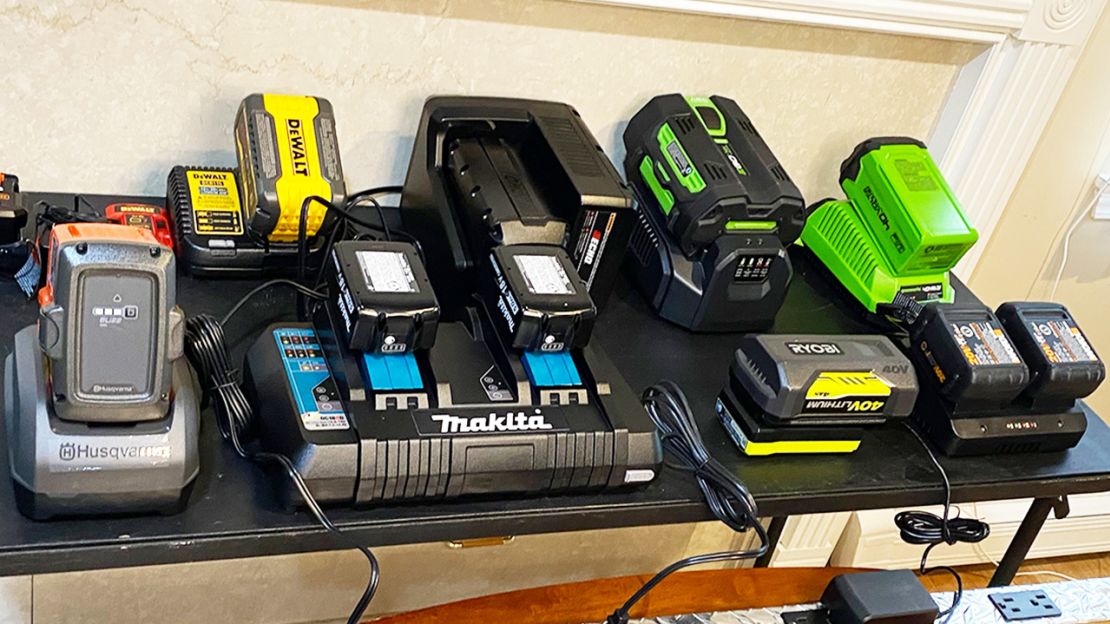
Electric leaf blowers that are not corded use batteries to run. Some models use one battery, while others use two batteries. Depending on how much each battery weighs, needing one or even two batteries does add weight to the unit, so keep that in mind as you prepare to carry around a leaf blower to clean up your yard of leaves. A quick checklist to keep in mind while choosing a battery-powered electric leaf blower is:
- Type: What kind of battery does the leaf blower use?
- Requirement: Does the leaf blower require one or two batteries?
- Charging station: Does the battery come with its own charging station? If so, how many batteries can it charge simultaneously?
- Recharging time: How long does it take to fully charge an empty battery?
- Cost: If you want to buy extra batteries, how much does each battery cost?
Ergonomics: Carefully consider the handle’s design
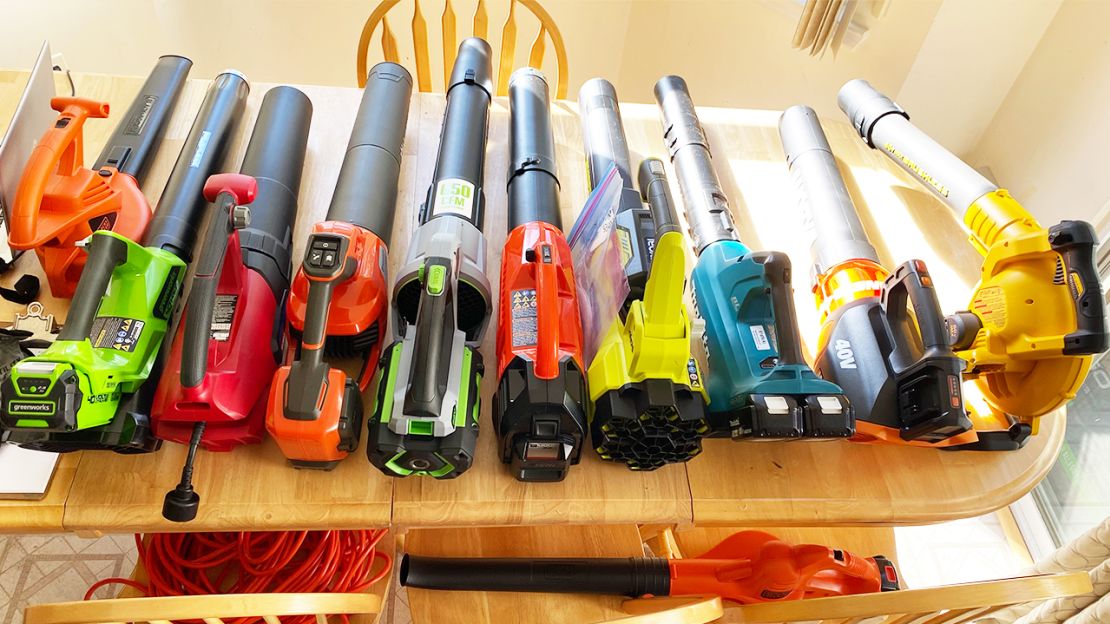
You’re going to want to check out the handles of any leaf blowers you are thinking of buying. A nicely designed, ergonomic handle really does make a world of difference when you need to carry the unit around for 20 to 30 minutes or more while cleaning up your yard. You want to look for a handle that is comfortable in either hand, which lets you switch off to the other hand when one gets tired. Make sure the handle is also located in a spot on the blower that evenly distributes the weight of the unit so that it’s easy to control and maneuver as you walk around your yard while blowing leaves. Also helpful is to choose a handle that has important speed control buttons located within easy reach. Tips to remember are:
- Ambidextrous: It’s an added bonus to choose a handle that either hand can use,
- Shape: Realize that the width or length of the handle can affect hand comfort during use.
- Location: Look for a handle that is located on a spot that helps evenly distribute the weight.
- Buttons: Choose a handle that has the speed control buttons on it so you can easily press them.
Extension cords: Need to buy one for the corded models
We used this sturdy extension cord to safely and securely use the two corded electric leaf blowers during testing. We used a 100-foot-long cord, but it comes in various sizes so you can buy the length you need to reach every corner of your yard.
Keep in mind that the leaf blowers we tested that did not use batteries needed to be attached to an extension cord. They didn’t come with their own power cord. The good news here is that you don’t have to be concerned with buying extra batteries or chargers if you want to get your leaf blowing task done faster. However, you do need to spend the extra money and buy an outdoor-rated extension cord in the appropriate length for your yard. We used a 100-foot-long cord, but you can choose a longer or shorter cord, according to your needs.
- Cord length: Buy a cord that will let you reach your entire yard’s approximate square footage.
- Outdoors rating: Make sure the cord you buy is rated for safe outdoors use.
- Electrical outlets: Learn the location of an electrical outlet that you can reach with the cord.
- Cord plug: Make sure each end of the extension cord can safely fit into both the outlet and the leaf blower.
Eco-friendliness: Electric blowers are quieter and cleaner than gas ones
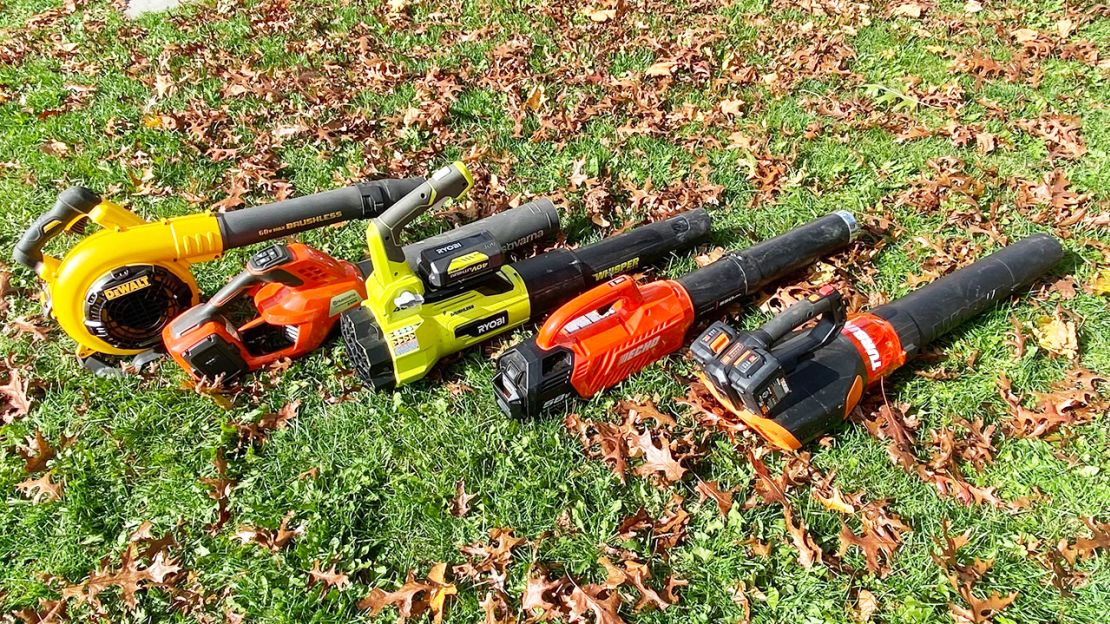
Before selecting a leaf blower, consider how electric leaf blowers operate at much lower decibel levels than gas models, which can create a quieter environment for everyone. In fact, noise complaints in suburban neighborhoods have become so widespread that many municipalities are moving to limit the use of gas leaf blowers due to complaints about their noise. For example, certain areas in New York have time restrictions on use, allowing gas leaf blowers only between 8 a.m. and 7 p.m. on weekdays and 9 a.m. and 6 p.m. weekends and holidays, as stated in New York City’s Noise Code.
Gas-powered leaf blowers can have a detrimental impact on the environment, so much so that some states are looking to enact bans on them. Opting for an electric leaf blower eliminates the need for you to buy gas for your blower or try to store smelly gas cans safely on your property.
How we tested
Researched the available models
To create our testing pool, first we ignored gas-powered and backpack leaf blowers entirely, because many municipalities across the country are now enforcing bans on their use altogether or setting limits on when they can be used.
We then researched hundreds of electric models to test. We focused mainly on selecting cordless models that are powered by rechargeable lithium-ion batteries, but we did also look for corded models since we know there are folks who prefer being able to use the blower longer in one session without needing to pause the action to recharge the battery or batteries.
Vetted the models based on various factors
We vetted our leaf blowers based on their relatively similar weights, power levels, speed levels and type of batteries used. Ultimately, we selected the following 12 blowers for testing: two corded models from Black+Decker and Toro, and 10 cordless (i.e., powered by rechargeable lithium-ion batteries) from Black+Decker, DeWalt, Echo, Ego, Greenworks, Ryobi, Toro and Worx.

Purchased additional testing materials
We also purchased a brown heavy-duty, waterproof tarp to blow the leaves onto, a 100-foot-long outdoors-rated extension cord to use for the corded blowers, a heavy-duty power strip surge protector into which we plugged all the batteries and 100 clear leaf bags to bag up the blown leaves during testing.
Unboxed the blowers and batteries
We unboxed each leaf blower, noting the sturdiness of construction of each one. We then unboxed each blower’s charger, setting them all up on a nearby table and plugging them in. We charged all of the leaf blowers one by one to make sure each was fully charged before initial use. We timed how long each battery took to fully charge.
Charged the batteries and started blowing
Next, we installed a fully charged battery or batteries into our first leaf blower and ventured out into our leaf-covered backyard with it. We set up our brown tarp in one corner of our yard, in the same spot each time. We timed how long it took for us to fully blow all the leaves within sight onto our tarp, using the most powerful setting on the blower first.
We noted whether or not we could do this task with one charge of a battery or whether we had to pause the blowing in order to charge up the battery or batteries again.
We then blew all the leaves into the opposite corner of the yard, using the lowest setting on the leaf blower. We timed how long that task took and whether we had to again charge the battery before our task was done.
Sought out professional landscaper input
To blow leaves of similarly sized yards in adjacent neighborhoods, and to make sure our results were mirrored by another, we enlisted the long-term help of a professional landscaper on Long Island, New York.?He used the electric leaf blowers to blow leaves at more than 20 client homes on weekends. This landscaper did not blow the leaves onto a tarp each time (like we did) but rather blew them into a pile and then bagged them up. The 12 electric leaf blowers took turns being used over the course of four seasons: two autumns and two springs.
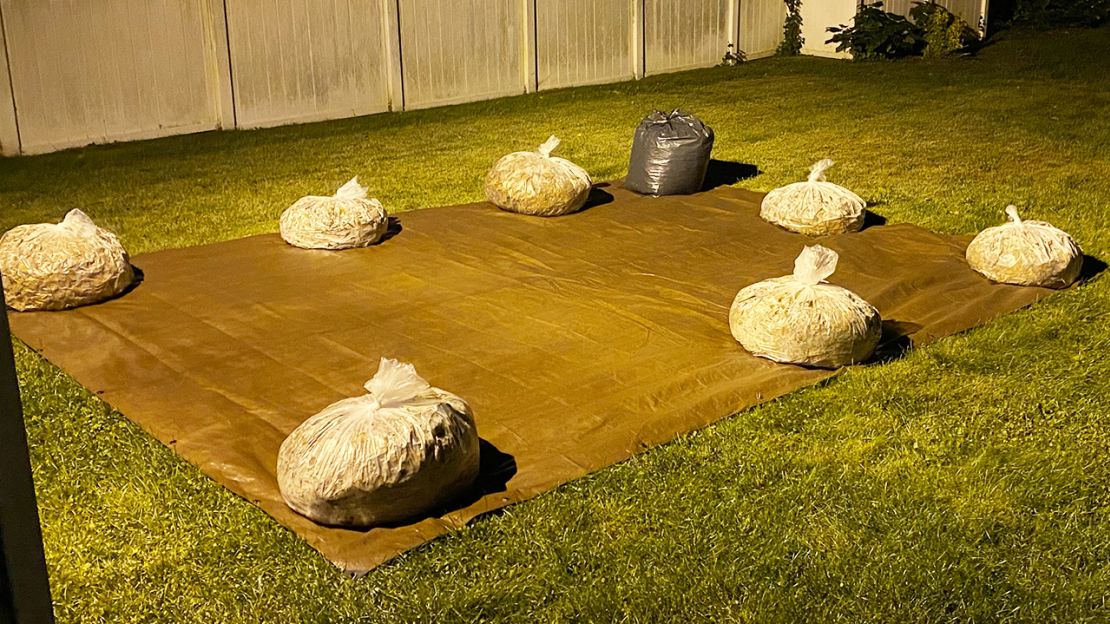
Recorded noise levels
We also recorded the leaf blowers’ noise levels by using the Sound Level Meter (SLM) app from the National Institute for Occupational Safety and Health (NIOSH) on our iPhone 11, which was set upon a table outside on our backyard deck, about 6 feet away from the leaf blower as it ran for one minute on its highest speed setting. We measured the noise levels produced by each leaf blower over a two-minute period while running at its highest speed in our otherwise quiet backyard using the NIOSH app.
All the leaf blowers we tested definitely made audible noise in operation. In the end, though, all the models’ noise levels sounded discernibly lower than the noise level of a running gas-powered leaf blower, according to our professional landscaper (who also uses gas-powered leaf blowers during normal business hours during the week). Therefore, as far as noise level goes, any of the electric leaf blowers we tested would be suitable for use in a suburban back or front yard.
Bagged the leaves up, then judged each blower
In the evenings, we bagged up all the leaves and set them aside. We noted how many bags each leaf blower was able to fill during its round of testing.
During testing, we judged each blower on how ergonomic and comfortable its handle was, how easy it was to maneuver and control the blower, and whether or not the blower’s weight began to be cumbersome. We noted the blower’s power and speed level controls as well as how loud the blower seemed to be while running on regular power versus full or Turbo-boosted power.
We noted each blower’s run time and battery life as well. For the corded models, we took notice of how easy it was to handle while walking around with the extension cord as well as all the other factors already mentioned.
Other leaf blowers we tested
Corded model:
Toro Leaf Blower F700
$93 at Amazon
The Toro Leaf Blower F700 was the only other corded leaf blower we tested in this round, pitting it against the Black+Decker LB700. This blower is lightweight but powerful; it can blow air up to 140 miles per hour and therefore move leaves and other debris quickly. We found its handle to be comfortable to grip and use in either hand, but we found it difficult to walk around with the unit while keeping our extension cord plugged into its included socket. It kept falling out — that is, until we wrapped our extension cord around the blower’s handle first, then plugged it in. We didn’t have this problem with the Black+Decker LB7000 corded blower, which is why the latter shares the top spot in our testing.
Cordless models:
Black+Decker LSW221
$99 $94 at Amazon
The Black+Decker LSW221 leaf blower was very lightweight, even with its single battery installed. At 3.7 pounds, it was easy for us to move it around as we blew our leaves from one area to another. The best thing we noticed about the blower was that it was relatively quiet, but its airflow wasn’t as powerful as the other cordless models. Because of this, it didn’t come out on top during our testing.
DeWalt DCBL770X1
$279 at Amazon
The DeWalt DCBL770X1 is a leaf blower whose airflow was strong and impressive. It got the job done quickly, but we found the unit to be too heavy to lug around for long. Most of the weight is distributed toward the back of the unit, which made it awkward for us to carry easily. Also, while the unit can be gripped with either hand, when we held onto it with our left hand, we found our clothing being a bit suctioned due to the pull of the exhaust fan. It just made it distracting to use with our left hand. For these reasons, it didn’t beat the Ego Power+ LB6504 in our testing.
Echo CPLB 58V2Ah
$435 at Amazon
We found the airflow from the Echo CPLB 58V2Ah leaf blower to be very strong, and we could grip the unit’s handle comfortably in either hand. It has a Turbo Boost button that helped us get our leaf blowing done faster, but we found that the button doesn’t click down in place once initially pressed. We had to continually hold the button down if we wanted that extra boost of power, something that we didn’t need to remember to do with the others. This is part of the reason why it didn’t beat the Ego Power+ LB6504 in our testing.
Ego Power+ LB5302
$199 at Lowe’s
The Ego Power+ LB5302 performed similarly to its more recent counterpart, the Ego Power+ LB6504. The LB5302 is also a sturdy, powerful blower that’s easy to use, thanks to its ergonomic handle. It also has a rechargeable lithium-ion battery that lasted a respectable amount of time, even when we used the blower at its highest speed level. If you want a fairly comparable unit at a more affordable price, you won’t go wrong choosing this older model. But the LB6504 performed just a little bit better and has a longer-lasting battery, which is why it took the top spot during testing.
Greenworks BA40L210
$170 $129 at Amazon
The Greenworks BA40L210 is a leaf blower that is highly maneuverable and comfortable to hold for both right-handed and left-handed users. We found it to be relatively lightweight but powerful, being able to move all our leaves into a huge pile quickly. The main downside to the blower was that we found it to be extremely loud compared to the others, which is why it didn’t beat the Ego Power+ LB6504 during testing.
Husqvarna 230iB
$320 $301 at Amazon
The Husqvarna 230iB leaf blower was the only one we tested that features a handy on/off switch, which prevents the blower from turning on if you randomly start pressing its speed buttons. Once we first held it, we found it to be a bit on the heavy side, but as we used it more, we liked how we could control it easily with either hand, and found its Boost button to provide very powerful airflow. However, it is a bit heavy, so that’s why it didn’t grab the top spot during our testing.
Makita XBU02PT
$280 at Amazon
The Makita XBU02PT leaf blower comes with two batteries and a charger, which takes up the biggest footprint of all the chargers in our test group. Once installed, the batteries don’t seem to add too much additional weight to the blower, which is easy to hold during use. We were able to comfortably hold the unit in either hand. We found the six blow speeds to be impressive, with the highest setting being both very strong but very loud. Its noise level was the main reason it didn’t win our top spot.
Ryobi 40-Volt 550 CFM
$199 at The Home Depot
The Ryobi 40-Volt 550 CFM leaf blower performed well during testing. It uses one battery, which comes with a charger. We found its handle nice to hold as it rested comfortably in our grip. We were also able to easily maneuver it using either hand. It’s a very powerful blower, and it offers a Boost button, which offers an even stronger airflow. But the blower was pretty loud during use, though it claims to be whisper quiet. This is why it didn’t beat the Ego Power+ LB6504 during testing.
Worx WG584
$220 $179 at Amazon
The Worx WG584 leaf blower features a three-speed Settings button that let us choose a variety of airflow speeds with ease. We found that its Turbo Boost button created a very strong airflow when we held it down. It does use two batteries, though, which loads up on top of the unit. We found it helpful that there are little buttons on them that light up, indicating how much charge is left during use. Like the other blowers we tested, its charger is also included. Needing two batteries that need charging before reuse was part of the reason why it didn’t beat out the Ego Power+ LB6504 in this round.
